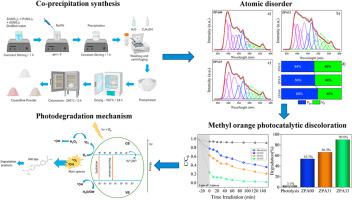当前位置:
X-MOL 学术
›
Mater. Chem. Phys.
›
论文详情
Our official English website, www.x-mol.net, welcomes your feedback! (Note: you will need to create a separate account there.)
Influence of Al cations insertion on the structural, morphological, optical properties, and methyl orange photocatalytic remotion of Pr-doped ZnO system
Materials Chemistry and Physics ( IF 4.6 ) Pub Date : 2024-04-04 , DOI: 10.1016/j.matchemphys.2024.129300 E. Martins , A.G. Jerônimo , R. Barbosa , L. Neves , E. Santos , T. Meira , Josy A. Osajima , Pollyana Trigueiro , A.S. Soares , Ramón R. Peña-Garcia
Materials Chemistry and Physics ( IF 4.6 ) Pub Date : 2024-04-04 , DOI: 10.1016/j.matchemphys.2024.129300 E. Martins , A.G. Jerônimo , R. Barbosa , L. Neves , E. Santos , T. Meira , Josy A. Osajima , Pollyana Trigueiro , A.S. Soares , Ramón R. Peña-Garcia

|
Zinc oxide is a wonder of nature because it has infinite properties. The boom of this semiconductor arises due to its versatility in optoelectronic applications and for being a hopeful material for environmental remediation. Changes in the synthesis parameters and one or more cations inclusion in the structure are alternatives used to make ZnO the most impressive semiconductor material. In this study, we synthesize and characterize the ZnPrAlO system, [x, y] = (0.00, 0.00); (0.03, 0.01); (0.03, 0.03) for use in the photocatalytic discoloration of methyl orange. Variations in structural parameters are linked to the Zn cations with Pr and Al cations replacement, as well as atomic disorder in the structure. According to Raman spectra, the E(high) characteristic of oxygen vibration in the ZnO crystal structure undergoes a small shift toward higher wavenumbers, suggesting the oxygen defects presence. The PL spectra were fitted using a Gaussian function, and the results confirmed high zinc vacancy (V) and neutral oxygen vacancy (V) concentrations in the ZnPrAlO compound. In addition, the Pr and Al ions insertion into ZnO causes variations in the band gap and Urbach energy. The Field Emission Scanning Electron Microscopy (FE-SEM) micrographs confirmed that the samples have irregular particle clusters. The photocatalytic tests demonstrated that the dopant contributed to increased methyl orange dye (MO) discoloration, reaching values between 53.7 and 90.0% of pollutant removal. The scavenger tests suggested that the reactive species responsible for the photodegradation/discoloration mechanism of the MO dye in solution are in the next order: •O > •OH > e > h. Finally, the samples maintained structural integrity after three consecutive reuse cycles while removing 22.7% of the MO dye. This study demonstrates the viability of inserting Pr and Al cations into the ZnO crystal structure to improve semiconductor efficiency for environmental applications.
中文翻译:

Al阳离子插入对Pr掺杂ZnO体系结构、形貌、光学性质和甲基橙光催化反应的影响
氧化锌是大自然的奇迹,因为它具有无限的特性。这种半导体的繁荣是由于其在光电应用中的多功能性以及作为环境修复的有希望的材料。合成参数的变化以及结构中包含一种或多种阳离子是使 ZnO 成为最令人印象深刻的半导体材料的替代方案。在本研究中,我们合成并表征了ZnPrAlO体系,[x, y] = (0.00, 0.00); (0.03,0.01); (0.03, 0.03) 用于甲基橙的光催化变色。结构参数的变化与被 Pr 和 Al 阳离子取代的 Zn 阳离子以及结构中的原子无序有关。根据拉曼光谱,ZnO晶体结构中氧振动的E(高)特征向更高波数发生小幅偏移,表明氧缺陷的存在。使用高斯函数拟合 PL 光谱,结果证实 ZnPrAlO 化合物中存在高锌空位 (V) 和中性氧空位 (V) 浓度。此外,Pr 和 Al 离子插入 ZnO 会导致带隙和 Urbach 能量的变化。场发射扫描电子显微镜(FE-SEM)显微照片证实样品具有不规则的颗粒簇。光催化测试表明,掺杂剂有助于增加甲基橙染料 (MO) 变色,污染物去除率达到 53.7% 至 90.0%。清除剂测试表明,负责溶液中 MO 染料光降解/变色机制的活性物质的顺序为:•O >•OH > e > h。最后,样品在连续三个重复使用周期后保持了结构完整性,同时去除了 22.7% 的 MO 染料。这项研究证明了将 Pr 和 Al 阳离子插入 ZnO 晶体结构中以提高环境应用的半导体效率的可行性。
更新日期:2024-04-04
中文翻译:

Al阳离子插入对Pr掺杂ZnO体系结构、形貌、光学性质和甲基橙光催化反应的影响
氧化锌是大自然的奇迹,因为它具有无限的特性。这种半导体的繁荣是由于其在光电应用中的多功能性以及作为环境修复的有希望的材料。合成参数的变化以及结构中包含一种或多种阳离子是使 ZnO 成为最令人印象深刻的半导体材料的替代方案。在本研究中,我们合成并表征了ZnPrAlO体系,[x, y] = (0.00, 0.00); (0.03,0.01); (0.03, 0.03) 用于甲基橙的光催化变色。结构参数的变化与被 Pr 和 Al 阳离子取代的 Zn 阳离子以及结构中的原子无序有关。根据拉曼光谱,ZnO晶体结构中氧振动的E(高)特征向更高波数发生小幅偏移,表明氧缺陷的存在。使用高斯函数拟合 PL 光谱,结果证实 ZnPrAlO 化合物中存在高锌空位 (V) 和中性氧空位 (V) 浓度。此外,Pr 和 Al 离子插入 ZnO 会导致带隙和 Urbach 能量的变化。场发射扫描电子显微镜(FE-SEM)显微照片证实样品具有不规则的颗粒簇。光催化测试表明,掺杂剂有助于增加甲基橙染料 (MO) 变色,污染物去除率达到 53.7% 至 90.0%。清除剂测试表明,负责溶液中 MO 染料光降解/变色机制的活性物质的顺序为:•O >•OH > e > h。最后,样品在连续三个重复使用周期后保持了结构完整性,同时去除了 22.7% 的 MO 染料。这项研究证明了将 Pr 和 Al 阳离子插入 ZnO 晶体结构中以提高环境应用的半导体效率的可行性。



























 京公网安备 11010802027423号
京公网安备 11010802027423号